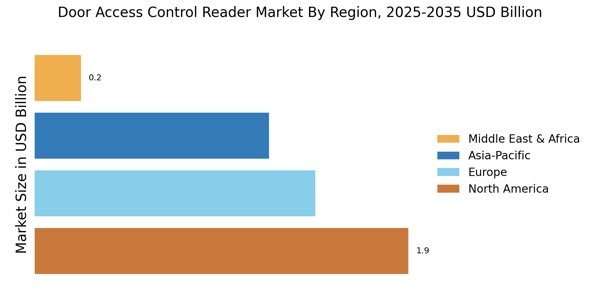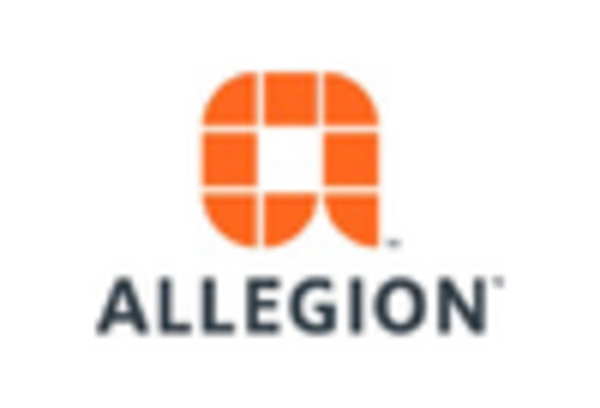Integration with IoT Solutions
The integration of Internet of Things (IoT) solutions within the Door Access Control Reader Market appears to be a pivotal driver. As organizations increasingly adopt smart technologies, the demand for access control systems that can seamlessly connect with IoT devices is on the rise. This integration facilitates enhanced security measures, real-time monitoring, and data analytics capabilities. According to recent estimates, the market for IoT-enabled access control systems is projected to grow at a compound annual growth rate of approximately 15% over the next five years. Consequently, the Door Access Control Reader Market is likely to witness a surge in demand for systems that offer interoperability with various IoT devices, thereby enhancing overall security and operational efficiency.
Regulatory Compliance and Standards
The increasing emphasis on regulatory compliance and industry standards is a crucial driver for the Door Access Control Reader Market. Organizations are required to adhere to various regulations concerning data protection and security, which necessitates the implementation of robust access control systems. Compliance with standards such as GDPR and HIPAA is becoming non-negotiable, prompting businesses to invest in advanced access control solutions. The market is expected to see a rise in demand for systems that not only meet these regulatory requirements but also provide comprehensive reporting and auditing capabilities. This trend indicates that the Door Access Control Reader Market will continue to evolve in response to regulatory pressures, driving innovation and investment in compliance-focused technologies.
Growing Demand for Enhanced Security
The escalating need for enhanced security measures across various sectors is a significant driver for the Door Access Control Reader Market. Organizations are increasingly prioritizing the protection of sensitive information and assets, leading to a heightened demand for advanced access control solutions. The market is projected to reach a valuation of USD 10 billion by 2026, reflecting a robust growth trajectory. This demand is particularly pronounced in sectors such as finance, healthcare, and government, where security breaches can have dire consequences. As a result, the Door Access Control Reader Market is likely to experience a shift towards more sophisticated technologies, including biometric and mobile access solutions, to meet the evolving security needs of organizations.
Technological Advancements in Access Control
Technological advancements are driving innovation within the Door Access Control Reader Market. The emergence of cutting-edge technologies, such as facial recognition, mobile credentials, and cloud-based access control systems, is reshaping the landscape of access management. These advancements not only enhance security but also improve user experience and operational efficiency. The market for advanced access control technologies is expected to grow significantly, with projections indicating a potential increase of 20% in adoption rates over the next few years. As organizations seek to leverage these technologies, the Door Access Control Reader Market is likely to witness a transformation in how access is managed and monitored, leading to more secure environments.
Increased Adoption of Mobile Access Solutions
The increased adoption of mobile access solutions is emerging as a significant driver within the Door Access Control Reader Market. As mobile technology continues to advance, organizations are recognizing the benefits of allowing employees to use their smartphones for access control. This shift not only enhances convenience but also aligns with the growing trend of remote work and flexible office environments. Recent data suggests that the mobile access control segment is expected to grow at a rate of 18% annually over the next five years. Consequently, the Door Access Control Reader Market is likely to see a surge in demand for mobile-compatible systems, which offer enhanced user experience and operational flexibility.

















Leave a Comment